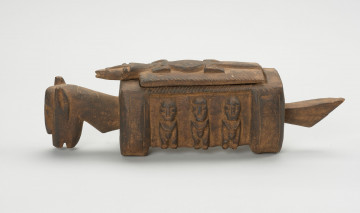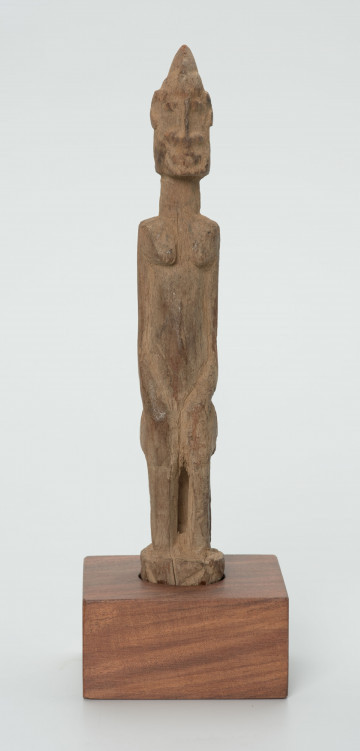Door lock with key
około 1970
National Museum in Szczecin
Part of the collection: Collection of Dogonian art
The Dogon are a people living in the south-central part of the Republic of Mali. Its number is estimated at 500-600 thousand. The largest concentration of their villages is located on a 150 km stretch along the Bandiagara Escarpment. The villages are located on the massif, on the plain spreading around it and the so-called debris, i.e. stony slopes and ravines at its foot. The lock to the door of the homestead or house of the great ginna family is called in the Dogo-so language ta koguru, which means attached to the door. Another type of lock, the duro kunu, which is hardly visible, is found among the Dogon locks. The ta koguru lock is attached to the door from the outside and richly decorated. The Dogon doors are made of several boards joined together with metal brackets and equipped with a hinge system called a pole. The door of the house always opens inwards. The homestead with the ginna house is the residence of the family's patriarch (ginna bana), who lives there together with his wives and children. Locks and doors (large ones leading to the homesteads and ginna houses and small ones to the granaries), and other wooden objects, including ancestor figurines, were traditionally made by iru smiths. At the turn of the 20th/21st century, a new group of crafts persons making souvenirs for tourists emerged in response to strong demand from the tourist market. The sale of art objects (masks, sculptures, decorated castles, doors covered with bas-reliefs) was an essential source of income for many Dogon families. Today, as a result of the political situation in the Republic of Mali, tourist traffic has completely died down. The ta koguru door locks are now a very popular collector's item. The specimen in question is topped with a representation of ancestors symbolising a guard and his wife.
Ewa Prądzyńska
Author / creator
Dimensions
cały obiekt: height: 35,6 cm, width: 26,2 cm
Object type
door
Creation time / dating
Creation / finding place
Identification number
Location / status
około 1970
National Museum in Szczecin

między 1951 — 2000
National Museum in Szczecin

między 1901 — 1950
National Museum in Szczecin
DISCOVER this TOPIC
Castle Museum in Łańcut
DISCOVER this PATH
Educational path